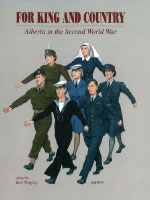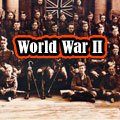The Northwest Staging Route
Carl A. Christie
Reprinted with permission of the author and publisher of For King and Country: Alberta in the Second World War When the new system worked well in the West and in the North, it was extended across the country. By the end of 1943 the RCAP controlled all air movements in Canada, and did so for the duration of the war.42 On the Northwest Staging Route, where atmospheric conditions rendered radio communications unreliable, some 2400 miles of land lines had to be installed, largely by American engineers.43 What it meant in terms of flying control was summed up by Air Vice-Marshal T.A. Lawrence, Air Officer Commanding North West Air Command, a new formation created in June 1944 to control the Northwest Staging Route and associated airfields in northwestern Canada:
When the new system worked well in the West and in the North, it was extended across the country. By the end of 1943 the RCAP controlled all air movements in Canada, and did so for the duration of the war.42 On the Northwest Staging Route, where atmospheric conditions rendered radio communications unreliable, some 2400 miles of land lines had to be installed, largely by American engineers.43 What it meant in terms of flying control was summed up by Air Vice-Marshal T.A. Lawrence, Air Officer Commanding North West Air Command, a new formation created in June 1944 to control the Northwest Staging Route and associated airfields in northwestern Canada:
The duty control officer in the airways centre in Edmonton can, by merely pushing one button, talk instantly to the Fairbanks control tower, or to any control tower between Edmonton and Fairbanks, or for that matter to Winnipeg, Calgary, Lethbridge, Great Falls, Montana or Vancouver. The system will work as smoothly ... as the ordinary inter-office telephone of any modem business building. 44
Although the British had not been involved in the negotiations with the Americans, or between the RCAF and the Department of Transport, they welcomed the introduction of a uniform set of procedures. Not only would this promote safety and efficiency; it would also strengthen the hold of Canada, and thus of the Commonwealth, on Goose Bay and Gander.
Confident that a good system of air traffic control had been developed in North America, and seeing the need for standardization, the government worked for an international agreement even before the end of the war. In March 1944 Howe explained the Canadian position:
It is obvious that air regulations dealing with such matters as traffic rules, safety and navigational aids should be as nearly as possible, uniform through the whole world and that an international authority must be set up and given the power to prepare regulations which would be accepted as standard by the members of that authority. 45
The development of a universal system of air traffic control thus became a major Canadian contribution growing out of the war. With a proposal by the United States more likely to be regarded with suspicion, Canada argued, with some British support, the merits of the Canadian-American system. Although most countries were reluctant to give up their own diverse practices the Canadian proposal, with some changes, was accepted for international air routes and Canadians went on to playa significant part in the co-ordination of international aviation.46
Procedures developed in western Canada thus formed the basis of the international system of air traffic control established in the postwar world. The little-known airway in the northwest played its small part in this story.
Throughout the war, and especially during the campaign in the Aleutian Islands, from May 1942 to June 1943, the Northwest Staging Route served as a crucial supply line. American expectations that the route would be the means of launching a northern air offensive against Japan proved illusory but led to an intensified drive to expand the capacities of the various staging posts. With the fading of the Japanese threat in the northern Pacific region, its chief military use was ferrying aircraft to the USSR, 2491 being delivered in 1943, 3148 in 1944, and 2143 in 1945.47 The official USAAF history summed it up:
As seen by the planners in December 1941, the wintry air road northwest was essential for supplying and reinforcing the pitifully small garrison of American forces in Alaska. Such was its principal occasion for being until September 1942, and throughout the war it continued to deliver to the United States' armed forces in Alaska aircraft and aircraft supplies. For three years, however, from September 1942 until September 1945, this airway's primary function was to deliver lend-lease aircraft, nearly 8,000 in all, to the aircrews of the Soviet Union, waiting at LADD Field, Fairbanks. 48
If it had been used for nothing else, this would have made the route a key contributor to the Allied victory.
In many respects the wartime saga of the Northwest Staging Route was simply a good example of the Canadian war effort in microcosm. We generously offered to do what we could, all the while fretting about the cost to our treasury and to our sovereignty. In the end we need not have worried. We came out of this episode smelling and looking good. We helped our American friends get personnel and materiel to Alaska for their own use in our common defence and for onward transmission to our Soviet ally. In the process we obtained modern facilities in the North that we could and did put to good use after the war.
Notes
42. “Air Traffic Control: Sub-Committee Minutes”, 20-30 Ag. 1943, DHist 181.002[D164]; R.C.A.F. Regulations for Control of Aircraft Movements [CAP 365, 2nd ed., May 1944], DHist 89/331.
43. See the unpublished history of RCAF landlines by an unidentified author [circa 1945] in DHist 181.009[D1038]. For the teletype circuit on the route, see RCAF file s.9-3, DHist 181.009[D1050].
44. Statement by Lawrence, 3 Feb. 1945, in Goddard, “North West Air Command”, chapter 2, C., section 33, DHist 74/6. See also RCAF file S.1-18 Vol. 2, “Summary - Canada-United States Joint Projects”, DHist 181.003[D5206], and RCAF file s.202-1-173 vol. 1, “Organization - North West Staging Route”, DHist 181.009[D1315].
45. Canada, Parliament, House of Commons, Debates, 1944, Vol. 2, 1578.
46. J.R.K. Main, Voyageurs of the Air: a History of civil Aviation in Canada, 1858-1967 [Ottawa 1967], pp. 193-4. As a corollary, Montreal was made the headquarters of the Provisional International civil Aviation Organization. Although Main says the choice was unanimous, “The final vote on the actual site was 27 for Montreal, 9 for Paris, 4 for Geneva, and 1 for China. After the vote had been taken the French graciously acknowledged the appropriateness of Montreal ....” Report of the Delegation to the First Meeting of the Interim Assembly of PICAO, 1946, Donald M. Page, ed., Documents on Canadian External Relations [DCER], Vol. 12: 1946 [Ottawa 1977], p. 523. See also the memo by the first secretary, “Mr. Symington's Visit to Washington”, 10 April 1946, John Hilliker, ed., DCER, Vol. 11: 1944-1945 Part II [Ottawa 1990], p. 559. See also Canada, Parliament, House of Commons, Debates, 1945, 585-6. For more on the strides made in air traffic control during the war, see Carl A. Christie, Ocean Bridge: The History of RAF Ferry Command [Toronto 1994], especially chapter 12.
47. Dziuban, Military Relations, p. 216. For more on the Northwest Staging Route, see John Stewart, “Canada and the Air Corridor to Alaska, 1935-42” [undergraduate thesis, Mount Allison University, Sackville, New Brunswick 1981], copy, DHist 81/332; K.C. Eyre, “Custos Borealis; the Military in the Canadian North” [PhD thesis, University of London 1981], pp. 82-95; Stan Cohen, The Forgotten War: A Pictorial History of World War II in Alaska and Northwestern Canada [Misoula, Montana 1981]; and Craven and Cate, op. cit., pp. 152-72. There are a large number of under-utilized files on the Northwestern Staging Route at the National Archives, in DOT as well as DND holdings, RG 12 and RG 24, and also in some private collections like the A.G.L. McNaughton Papers, Manuscript Group [MG] 30 E 133, and those of S/L Joachim Jaworski, MG 30 E 214. In addition, DHist still holds several useful files on the subject.
48. Craven and Cate, op. cit. p. 153. For more on the delivery of aircraft to the USSR, and also to the Royal air Force, see Christie, op. cit., passim.








